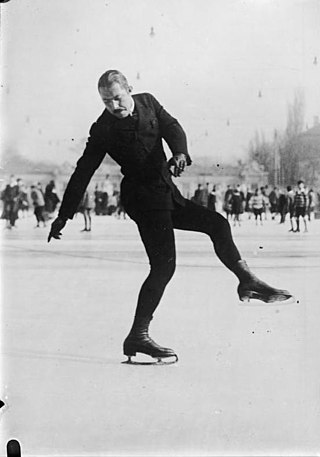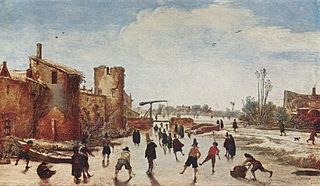
Karl Emil Julius Ulrich Salchow was a Danish-born Swedish figure skater, who dominated the sport in the first decade of the 20th century.

Compulsory figures or school figures were formerly a segment of figure skating, and gave the sport its name. They are the "circular patterns which skaters trace on the ice to demonstrate skill in placing clean turns evenly on round circles". For approximately the first 50 years of figure skating as a sport, until 1947, compulsory figures made up 60 percent of the total score at most competitions around the world. These figures continued to dominate the sport, although they steadily declined in importance, until the International Skating Union (ISU) voted to discontinue them as a part of competitions in 1990. Learning and training in compulsory figures instilled discipline and control; some in the figure skating community considered them necessary to teach skaters basic skills. Skaters would train for hours to learn and execute them well, and competing and judging figures would often take up to eight hours during competitions.

Ernst Baier was a German figure skater who competed in pair skating and single skating. He became Olympic pair champion in 1936 together with Maxi Herber. The duo also won several World and European championships.

The European Figure Skating Championships are an annual figure skating competition in which figure skaters compete for the title of European champion. Medals are awarded in men's singles, women's singles, pair skating, and ice dance. The event is sanctioned by the International Skating Union (ISU) and is the sport's oldest competition. The first European Championships were held in 1891 in Hamburg, Germany, and featured one segment, compulsory figures, with seven competitors. They have been held continuously since 1891, with only five interruptions, and have been sanctioned by the ISU since 1893. Women were allowed to compete for the first time in 1930, which is also the first time pair skating was added to the competition. Ice dance was added in 1954. Only eligible skaters from ISU member countries in Europe are allowed to compete.

Pierre Émile Ernest Brunet was a figure skater. Together with his wife Andrée Brunet he won Olympic medals in 1924, 1928 and 1932, as well as four world titles between 1926 and 1932 in pair skating. He also competed in singles, winning the national title in 1924–1931 and finishing seventh-eighth at the 1924 and 1928 Winter Olympics.
Fritz Kachler was an Austrian figure skater. He was the 1912, 1913, and 1923 World champion and the 1914 & 1924 European champion.

Willy Böckl was an Austrian figure skater. He won the World Figure Skating Championships four times and captured two silver medals at the Winter Olympics, and he also won six European Championship titles. After the end of World War I, beginning in 1922, he won the European championships six times, except for 1924, when he did not compete. Also in 1922, he came in third place at the World Championships. He came in second place at the 1923 and 1924 World Championships, and then between 1925 and 1928, won the next four Worlds. He earned two silver medals at the Olympics in 1924 and 1928, both behind Swedish skater Gillis Grafström. He defeated Grafström in the free skating portion at the 1924 Olympics.
The men's singles was one of four events in figure skating at the 1908 Summer Olympics. Each nation could enter up to 3 skaters. Sweden's Ulrich Salchow, who had won several World Figure Skating Championships, easily won the gold medal after his main rival, Russia's Nikolai Panin, withdrew either in protest over what he considered unfair judging or due to illness.

Friederike "Fritzi" Burger was an Austrian figure skater. She was a two-time Olympic silver medalist, a four-time World medalist, the 1930 European champion, and a four-time Austrian national champion (1928–1931).

The history of figure skating stretches back to prehistoric times. Primitive ice skates appear in the archaeological record from about 3000 BC. Edges were added by the Dutch in the 13th and 14th century. International figure skating competitions began appearing in the late 19th century; in 1891, the European Championships were inaugurated in Hamburg, Germany, and in 1896, the first World Championship were held in Saint Petersburg, Russian Empire. At the 1908 Summer Olympics in London, England, figure skating became the first winter sport to be included in the Olympics.
Gustav Hügel was an Austrian figure skater. He was the 1897 and 1899-1900 World Champion and the 1901 European Champion. He won the German national championships in 1894 because, at that time, Austria and Germany held joint championships.
The World Figure Skating Championships is an annual figure skating competition sanctioned by the International Skating Union in which figure skaters compete for the title of World Champion.
The World Figure Skating Championships is an annual figure skating competition sanctioned by the International Skating Union in which figure skaters compete for the title of World Champion. Men's and pairs' competitions took place from February 14 to 15 in Vienna, Austria. Ladies' competitions took place from January 31 to February 1 in Davos, Switzerland.
The World Figure Skating Championships is an annual figure skating competition sanctioned by the International Skating Union in which figure skaters compete for the title of World Champion.

Isaac Irving Brokaw was an American figure skater, artist, lawyer, and financier. He represented the United States at the 1908 Summer Olympics in the figure skating competition, becoming the first American to compete in a sport included in the Winter Olympic program. After he won an international prize in Switzerland, he brought the International Style of skating back to the United States. His book, The Art of Skating, was known as the figure skater's bible.
The 1914 European Figure Skating Championships were held on February 8 in Vienna, Austria. Elite figure skaters competed for the title of European Champion in the category of men's singles. These were the last European Championships in Figure Skating before World War I.
Otto Preißecker also Preissecker was an Austrian figure skater who competed in men's singles and pairs. As a single skater, he became a three-time World medalist, a three-time European medalist, and a three-time national champion (1926–1928). As a pair skater with Gisela Hochhaltinger, he was the 1930 European bronze medalist and a two-time national silver medalist.
Georg Zachariades was an Austrian industrialist, figure skater and racing cyclist of Greek descent.
Soňa (Sonja) Balunová, née Buriánová was a Czechoslovak pair skater. With Miloslav Balun, she became the 1954 European bronze medalist and a six-time national champion. She also competed in volleyball and athletics.
Miloslav Balun was a Czechoslovak pair skater. With Soňa Balunová, he became the 1954 European bronze medalist and a six-time national champion. He also competed in volleyball.









